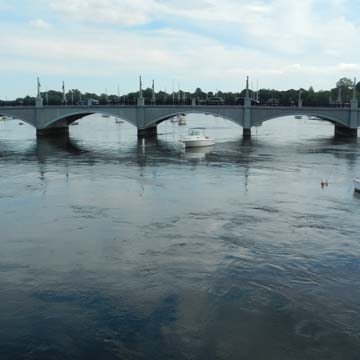The narrow tip of New Meadow Neck, which separates the Barrington and Palmer rivers where they join to form the Warren River, is flanked by these bridges, which carry County Road. Both are of reinforced concrete construction, with shallow segmental arches springing from stone piers to support slightly humpbacked roadbeds. Their classic design recalls antique European models, an image once reinforced by the original balustrades with urn-shaped balusters, destroyed in the hurricane of 1938 and replaced with the present solid, paneled balustrades. Historically, the erection of these twin bridges constituted the largest project in the first round of bridge construction undertaken after the establishment in 1912 of the Bridge Division of the State Board of Public Roads. State bridge engineer Clarence L. Hussey was a pioneer in the use of reinforced concrete for bridge construction in the early twentieth century. Though the Bridge Division made it a priority to develop standardized designs that could be adapted to many applications, the Barrington and Warren bridges are unusual in their employment of multiple solidarch spans. They are graceful embellishments along this route, a major link between Providence and Newport.
You are here
Barrington and Warren Bridges
If SAH Archipedia has been useful to you, please consider supporting it.
SAH Archipedia tells the story of the United States through its buildings, landscapes, and cities. This freely available resource empowers the public with authoritative knowledge that deepens their understanding and appreciation of the built environment. But the Society of Architectural Historians, which created SAH Archipedia with University of Virginia Press, needs your support to maintain the high-caliber research, writing, photography, cartography, editing, design, and programming that make SAH Archipedia a trusted online resource available to all who value the history of place, heritage tourism, and learning.














